The Rofis R1 continues what Rofis is known for: multi-angle, high-power multipurpose flashlights. How is it multipurpose? The head rotates, allowing the R1 to be used as a traditional flashlight, a right-angle clip light, or even a headlamp (headband is included). It uses an XM-L2 emitter and single 16340/RCR123 battery to achieve over 900 lumens while offering the convenience of internal recharging.

Here are the key review details:
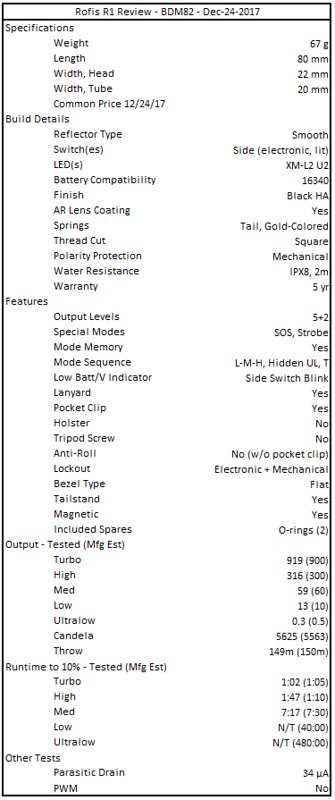
Skip to the commentary section at bottom to read my subjective notes on the R1.
Disclaimer: This light was provided free of charge by Rofis, shipping direct from Hong Kong. As December 24, 2017, the light can be purchased through Amazon (U.S.), Gearbest, or Banggood for $69.95. This review was completed over about 6 weeks of testing and real-world use.
Unboxing
The R1 arrived well-packaged; the retail box was nestled in a padded cardboard box inside the shipping envelope.
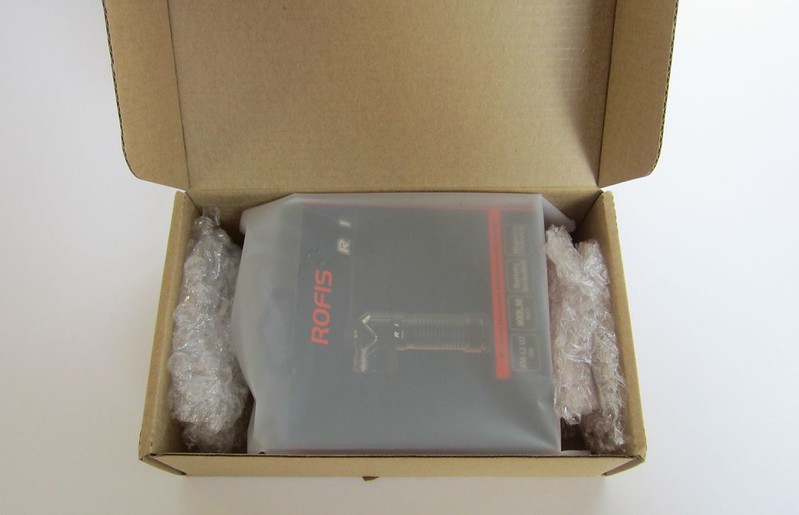
The front of the retail box advertises the LED, output, battery, and magnetic recharging.

With the false front open, many more features of the R1 are presented – as well as a window to see the R1 itself.
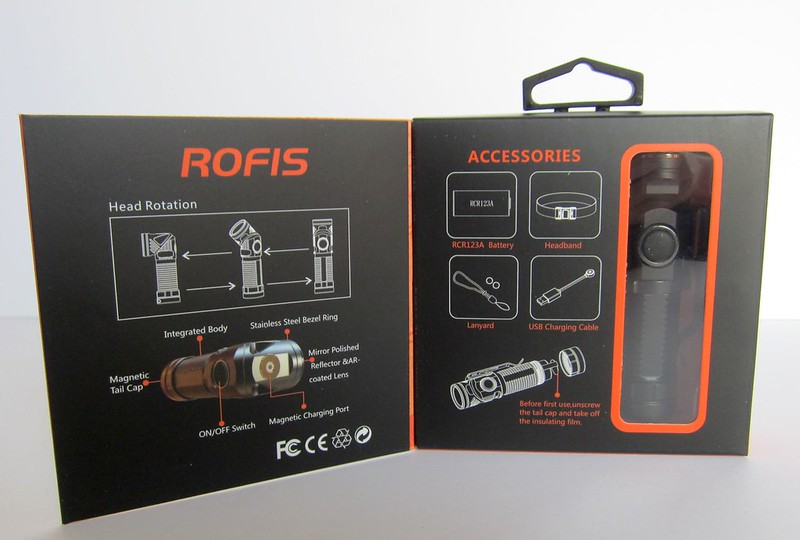
ANSI specs are presented on one of the box sides.
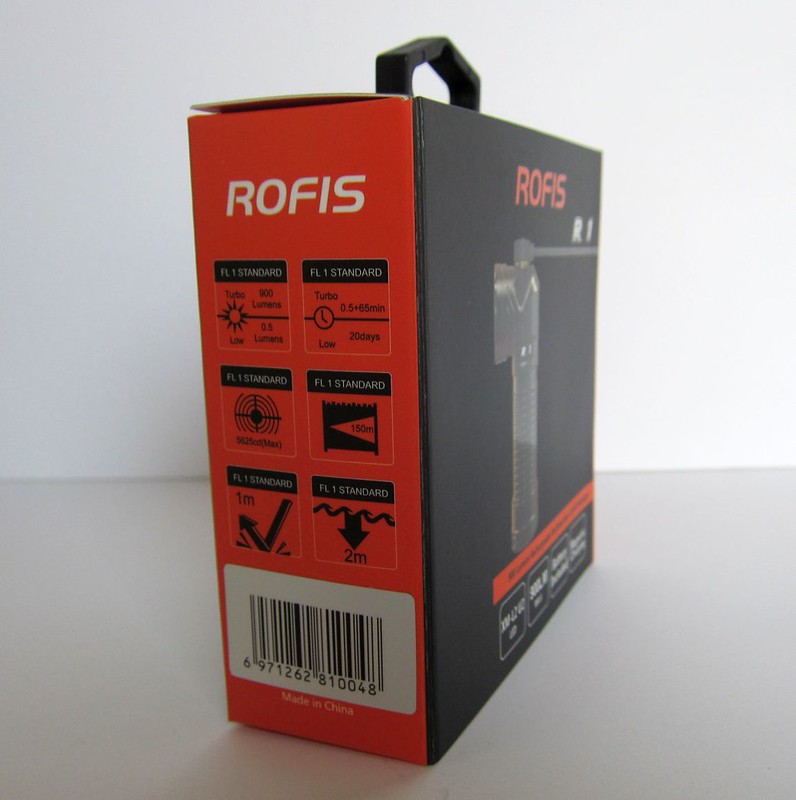
The other side has images of the light and headband. The rear has a runtime and output table as well as other information about the R1's features and Rofis as a company.
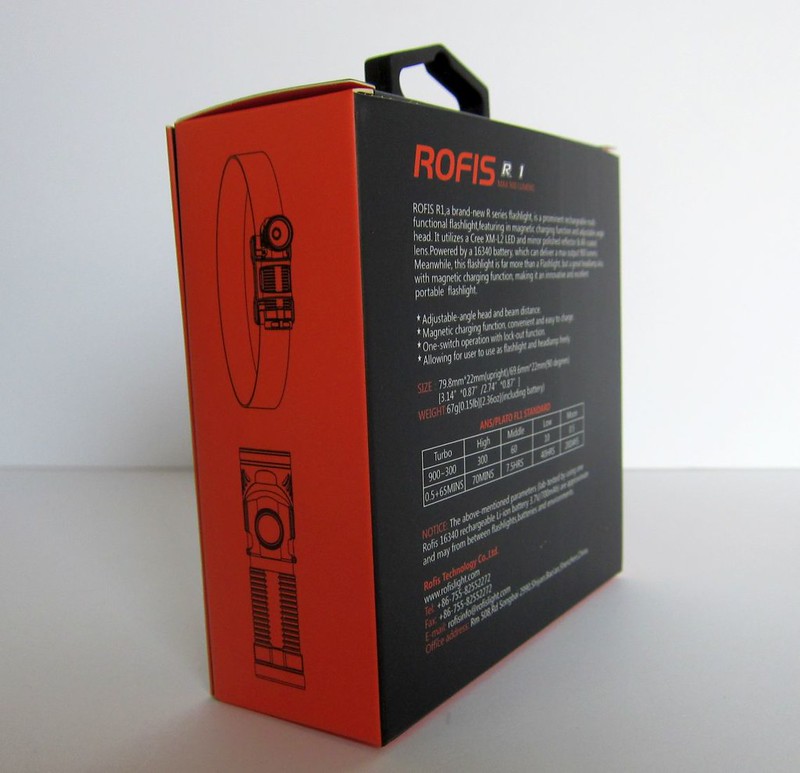
Rofis includes everything that's possibly needed with the R1: two spare o-rings, headband, lanyard (tucked inside headlamp mount), pocket click (pre-installed), battery (pre-installed), charging cable, warranty card, and instruction manual.

The manual itself is written in 7 languages: English, Chinese, French, German, Spanish, Italian, and Japanese. Content is quite complete though text is small.
The manual is also available online:
http://www.rofislight.com/wp-content/uploads/2017/09/ROFIS-R1-USER-MANUAL.pdf
Rofis backs the R1 with a 5-year warranty. Repair after 5 years is available for the cost of shipping and parts.
Design
The Rofis R1 is a small, easily pocketable RCR123 (16340) -based flashlight. It is about the same size as Rofis R10, its non-rechargeable stablemate. The R1 is slightly longer than a single 18650.
Rofis lists the length at 79.8 mm (69.6 mm when in right-angle mode), width at 22 mm, and weight at 67 g. My measurements confirmed these specs to the nearest mm/g noting that the battery tube is 20.2 mm.
For comparison, here is the R1 with various other lights (and the batteries they use).
L to R: Olight R50 Pro (26650), Manker E11 (AA), Astrolux S41S (18350), 18650 battery, Rofis R1 (16340), Olight S1R (16340), Manker E02 (AAA), Lumintop Tool (AAA), Nitecore EC23 (18650).
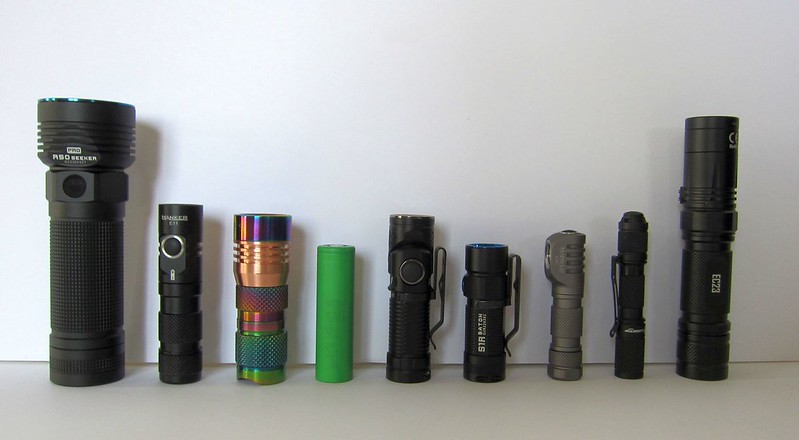
Of those lights, the Olight S1R is the closest direct competitor to the R1. The Olight is a bit more compact, but what's unique about the R1 is the rotating head that allows it to transform into a right-angle light or headlamp. The other lights lack this versatility.
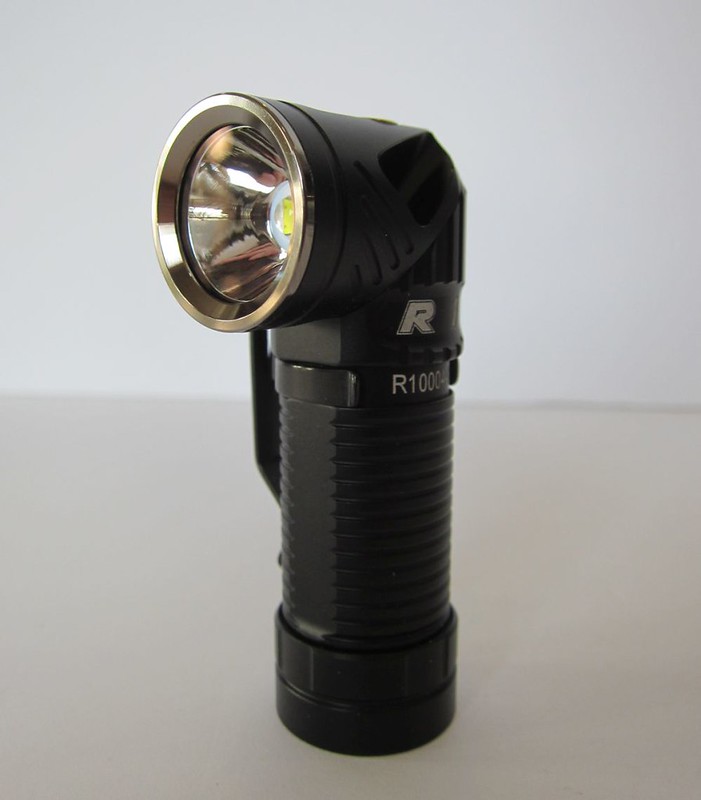
The R1 can be used with the head at any angle. There is a slight notch felt and click heard as the R1 hits straight or right-angle – but the R1 functions no matter how the head is adjusted.

Here's the R1 along with other small EDC-size lights (and the batteries they use).
L to R: Rofis 16340 battery, Fenix E15 (16340), Olight S1R (16340), Rofis R1 (16340), Thorfire TG06 (AA), BLF348 (AAA), Utorch UT01 (AA), Lumintop Tool (AAA), Orcatorch EA01 (AAA).

The head of R1 has a flat stainless bezel. Being flat, light won't escape if the light is placed head-down on a flat surface while on, but it is comfortable in a pocket. I was not able to remove the bezel by hand.
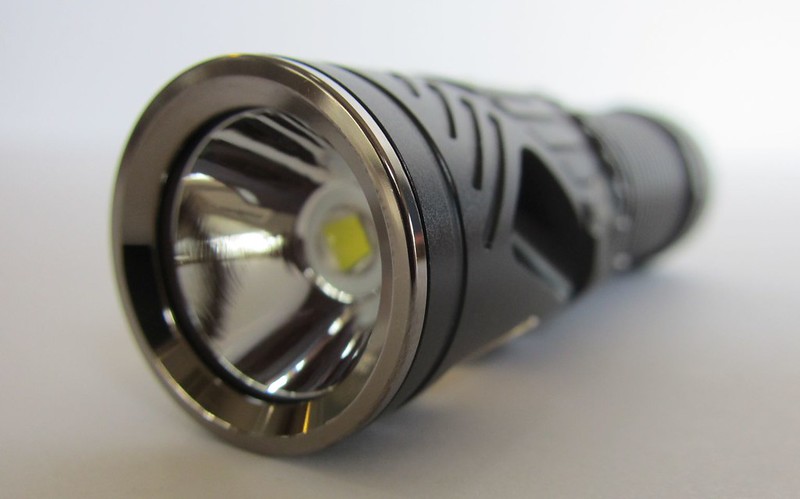
The lens is AR-coated. The coating is minimally purple, a good thing. The reflector is smooth and void of any imperfections. The XM-L2 emitter is centered well, though the reflector is shallow and there is space horizontally between the reflector and LED.
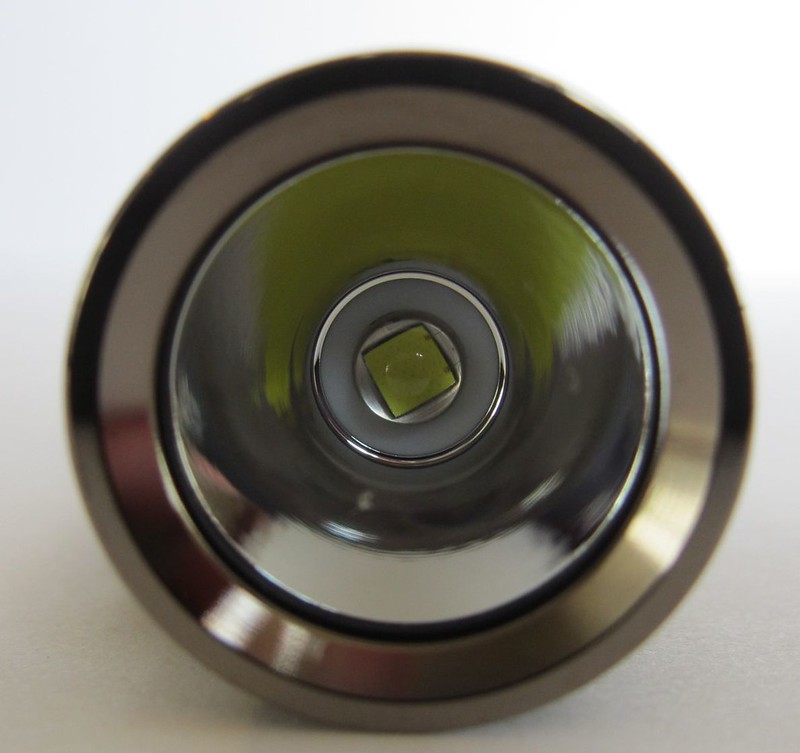
The head of the R1 has the charging port and a triangularly-shaped indention on each side that give the head a unique look.
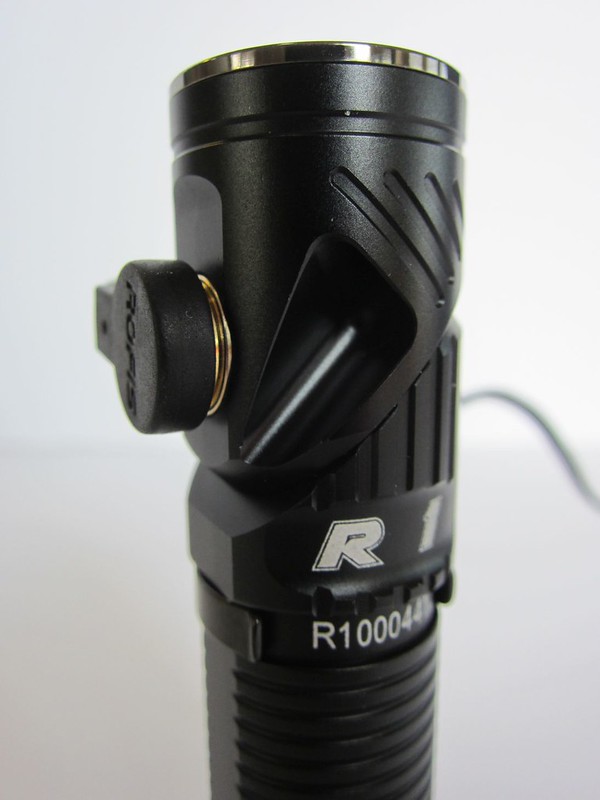
The charging port is a dual-ring disc that the charging cable attaches to magnetically. When the head is oriented in a right angle, the charging port is on the end of the light.
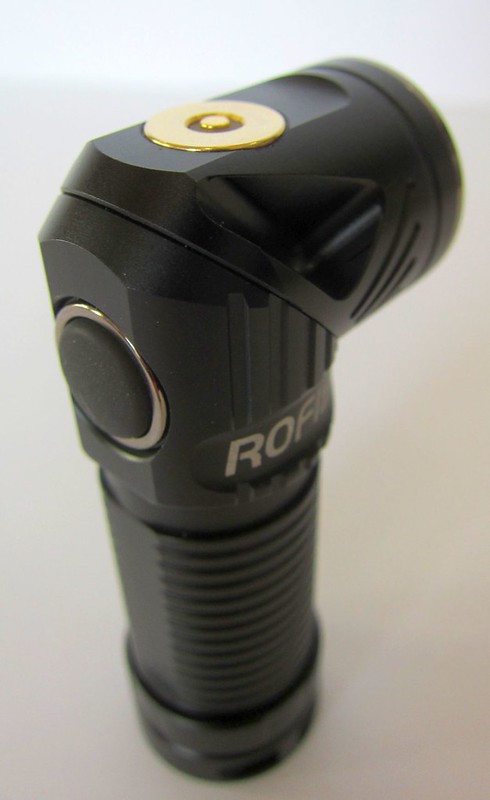
The side switch is a translucent black rubber circle inside a stainless ring. The switch doubles as a battery indicator; when the tail cap is tightened it will glow green for 2 seconds if the charge is >50%, glow red if the charge is 10-50%, or flash red if the charge is <10%. When in use, the switch will also flash if the battery charge is nearly depleted.
The switch is moderately easy to locate in hand and has good feedback and responsiveness.

To one side of the switch is the Rofis logo; to the other side is the R1 logo and serial number. Both the Rofis and R1 embossing are set into slightly recessed areas – which should deter wear and tear on the embossing.
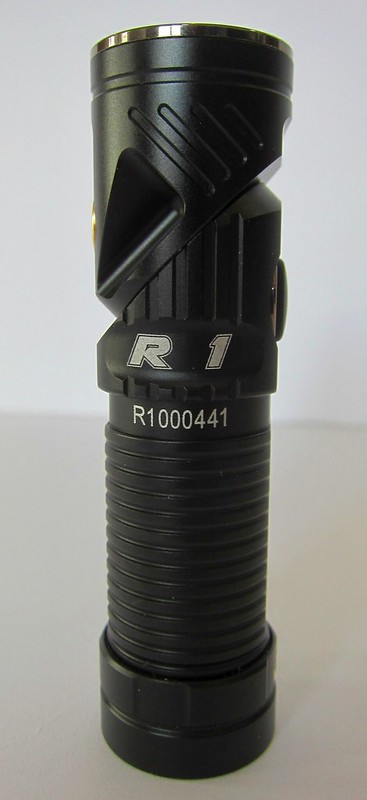
The R1's battery tube is slightly narrower than the rest of the light. It has ridges most of the way around the tube – other than two flat sides. There is no writing on these flat areas. I found they added useful grip to keep the light from spinning in hand when removing the tail cap.
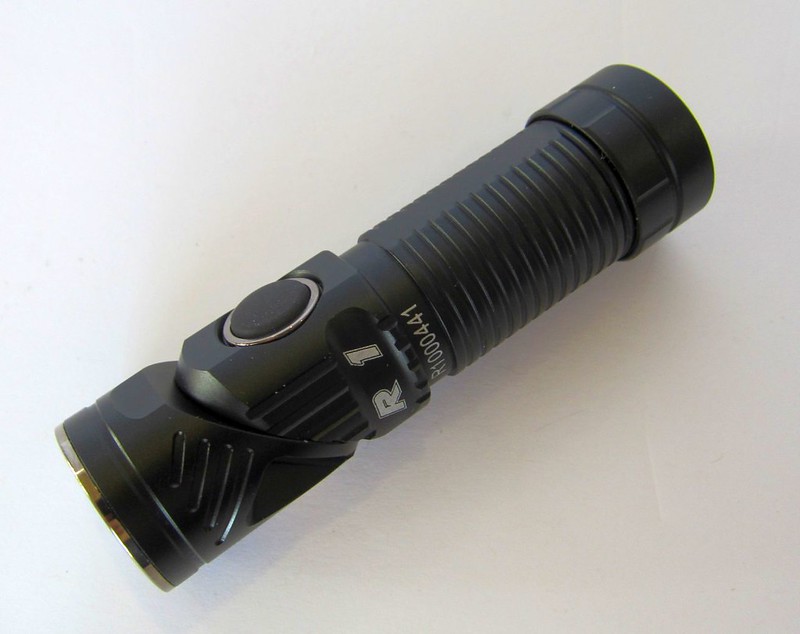
The tail cap has a lanyard hole to one side. It isn't overly large so some patience (or a small tool) is required to thread the lanyard. Being on the side of the tail cap, it doesn't hinder tail standing at all.

The tail itself is basically flat. It has a magnet inside and is strong enough to hold the R1 vertically or horizontally. (Dust is visible on the tail cap in this picture but know the anodization is clean.)
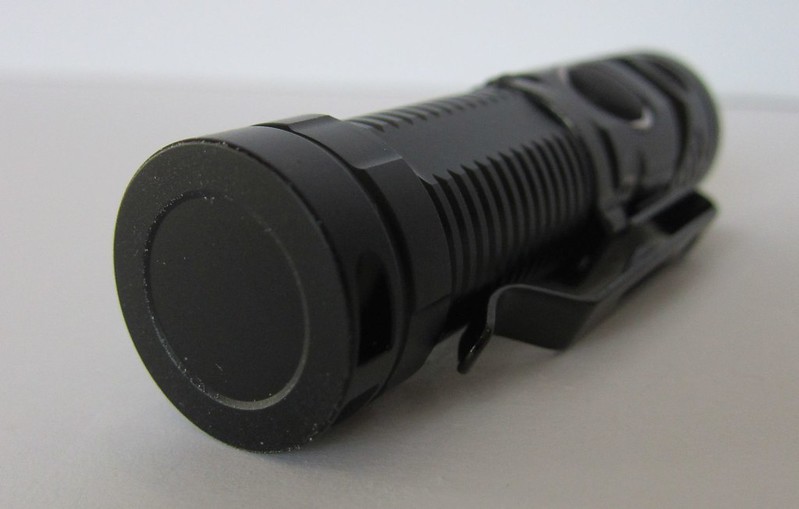
The battery tube has anodized square-cut threads – so a partial turn of the tail cap will mechanically lock the light out. Lubrication is lacking – as visible in the picture below. An o-ring helps prevent water ingress; Rofis rates the R1 as IPX-8 to 2 meters underwater.
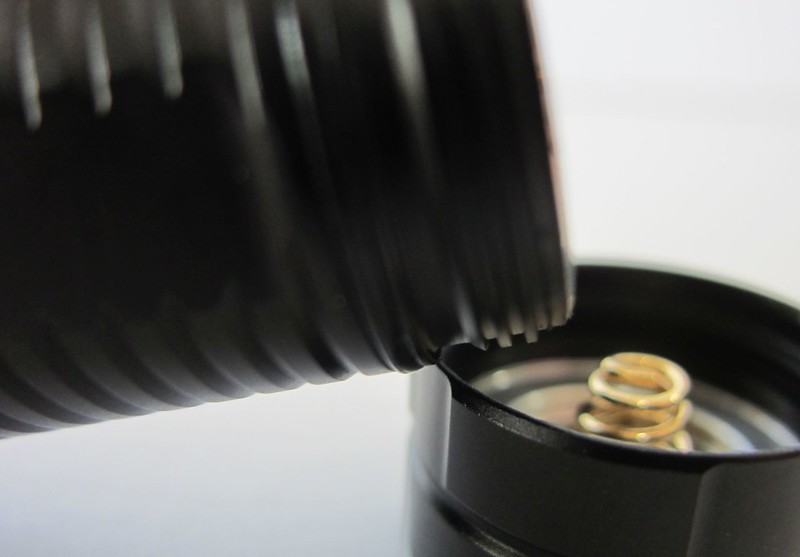
The tail cap has a single gold-colored spring.
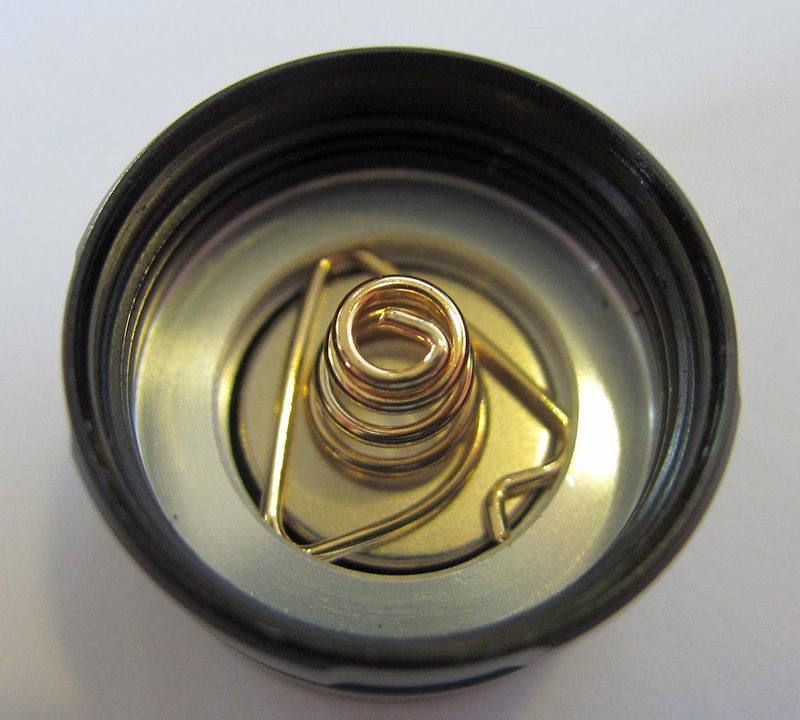
The head has a single gold-colored post surrounded by a shallower ring. This adds protection against cells inserted backwards – but does mean that button-top cells are required.
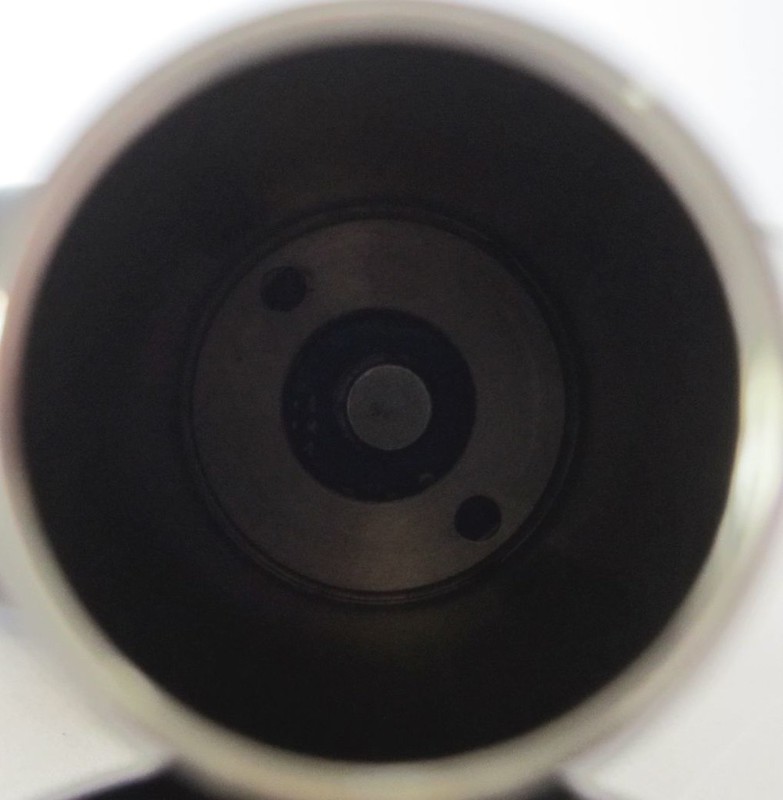
I tested with other 16340 batteries and found that Fenix 700mAh and Nitecore NL166 650mAh button-top cells were functional, though Turbo did trip the protection on the Nitecore cell. Thus, I'd recommend using the provided Rofis battery or another highly capable cell like the Fenix.
Accessories
Pocket Clip
The pocket clip is designed for head-up carry only. The strength is just about right – it is strong enough to not come off easily but not so strong that it's difficult to install or remove. The square edge where the clip transitions to wrap the body of the light (just below the Rofis embossing here) can catch when slipping onto a pocket.
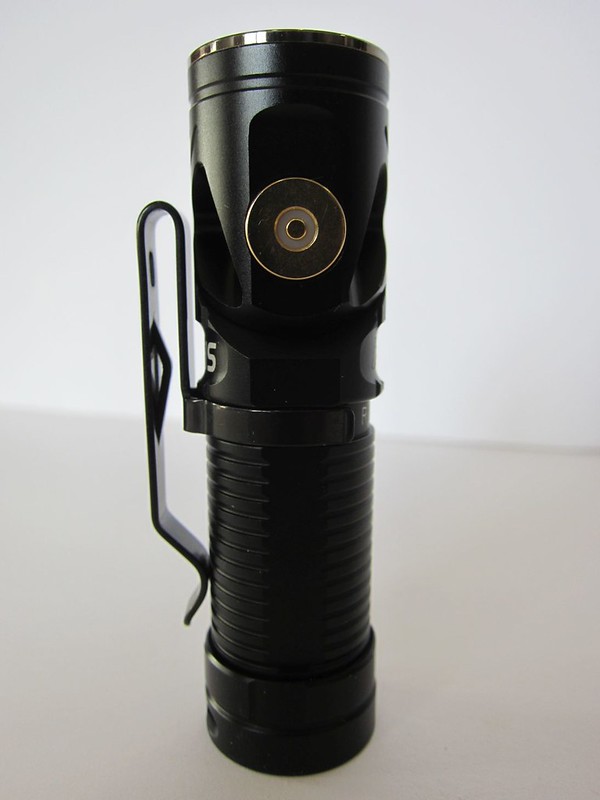
Headband
Right-angle flashlights make great headlamps – and Rofis included a headband and mount for this purpose. The R1 slips into the rubber mount from either direction. The band holds the R1 securely at whatever angle is desired. The pocket clip can be left in place, though in that case the clip goes outside of the rings while the light slips inside them. This can make installing and rotating the R1 challenging, so I found it best to remove the clip before using as a headlamp.

One drawback to the switch's location is that when on the headband, the switch is on the back side of the light. It is accessible but large fingers or gloved hands will find it tricky. If the charging port and switch were swapped, it would have put the switch on the end – making it easier to use.
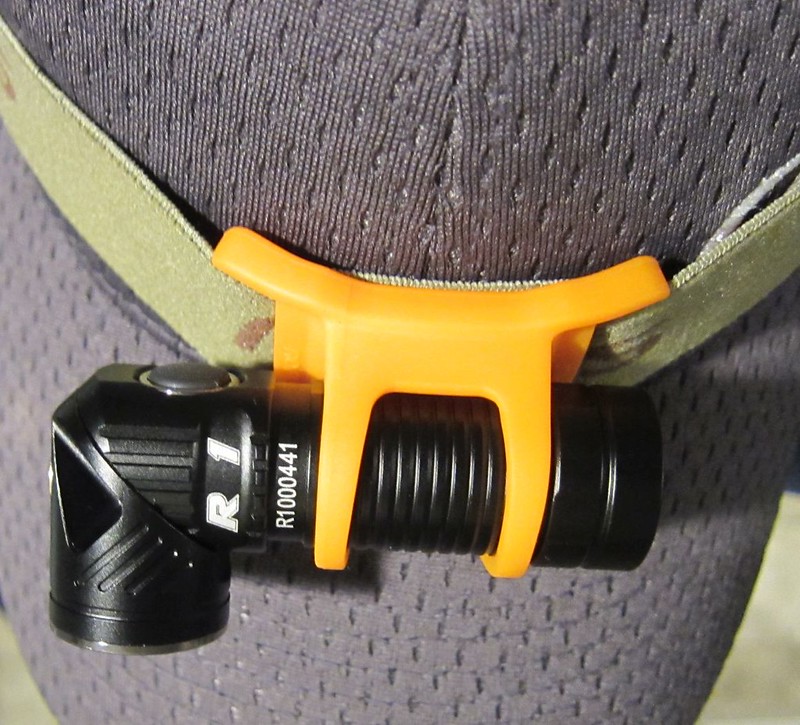
Performance
Beam
The XM-L2 is a single die emitter so there's no crosshair to deal with like with quad-die emitters. The R1's smooth but shallow reflector produces a defined but wide hotspot. Spill is plenty bright to be useful.

Tint & Temperature
The color and CCT are not specified by Rofis but I found the XM-L2 to have a slightly yellow hotspot and very cool, blue spill. CCT also varied highly, registering between around 4800 in hotspot and 7900K out in the spill. Most of the hotspot was around 5000K with most of the spill around 6500K (tested on Medium).
To demonstrate the overall color balance, here is the R1 surrounded by lights with emitters of various tints and temperatures on lower output modes. Camera W/B set to daylight.
L to R: Fenix E15 (XP-G2 R5), Olight S1R (XM-L2), Nitecore EC23 (XHP35 HD E2), Rofis R1, Convoy S2+ (XM-L2 T6 4C), Convoy S2+ (XM-L2 T6 4C), BLF348 (219B SW50).
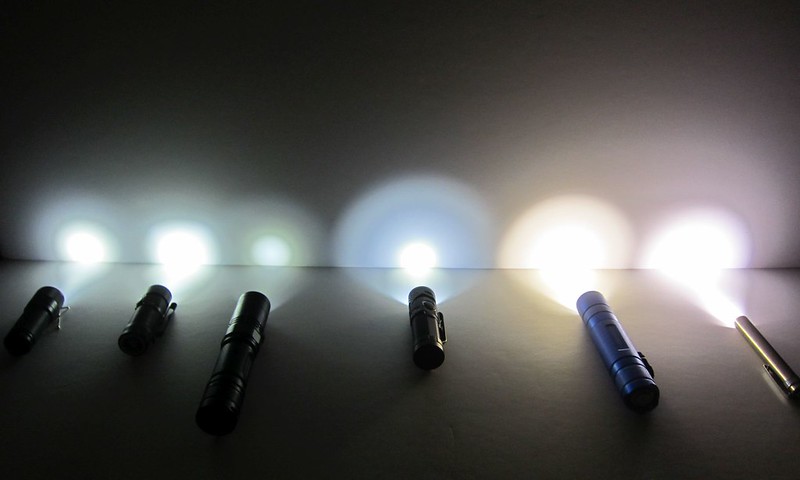
Alongside other cool temperature lights, the R1 blends in a bit more. Camera W/B still set to daylight; brighter modes due to lack of lower modes on some lights in shot.
L to R: Nitecore EC23 (XHP35 HD E2), Emisar D1vn (modded w/SST-40), Rofis R1, Convoy S2+ (XM-L2 U2 1B), Orcatorch EA01 (XP-G2 R5), Fenix E15 (XP-G2 R5)
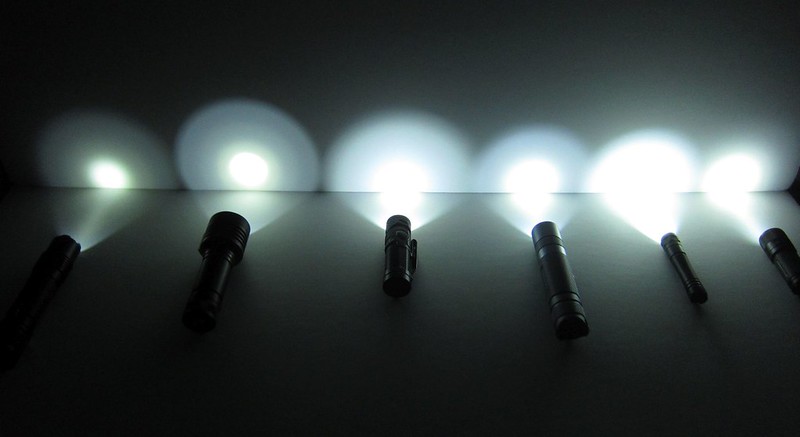
Output
Rofis rates the R1 at 900 lumens on Turbo with the included 16340/RCR123 700mAh cell. The box and manual make it clear that the light then steps down to 300 lumens at 30 seconds, and that it does.
I tested 993 lumens at turn-on and 919 lumens at 30 seconds with ambient temperature of 72F (22C).
Output dropped sharply right at 30 seconds and stabilized at 314 lumens.

This output was maintained with flat regulation until just past 62 minutes – when output was reduced to 62 lumens. This is within 3 minutes of Rofis's provided runtime of 65 minutes – validating the specification. Eventually the R1 stepped down to 13 lumens at 1:46 and powered off at 2:57. Temperature never exceeded 102F (39C).
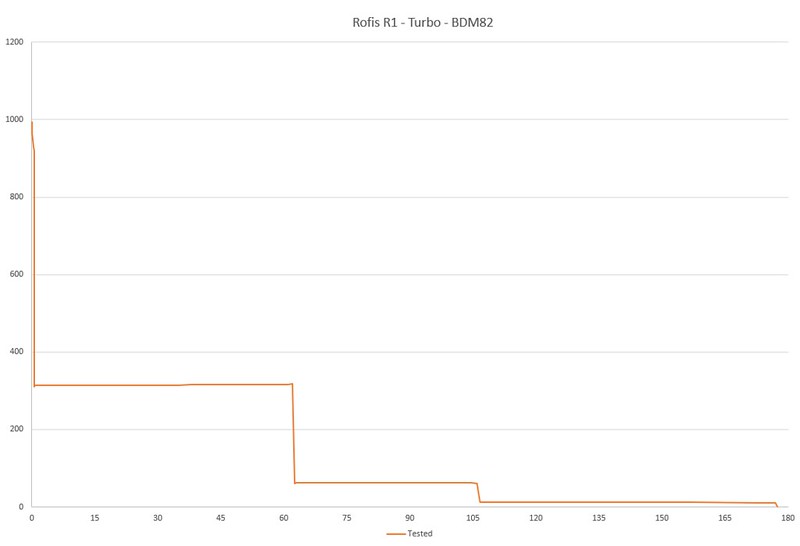
High is rated by Rofis at 300 lumens for 70 minutes. I measured a very close 316 lumens at 30 seconds. Output was flat, fluctuating only a couple lumens until after 65 minutes – when it stepped down to 59 lumens. It stepped down again at 1:47 to 13 lumens before turning off at 2:48. Rofis appears to have rated the runtime based on the first stepdown – but <10% wasn't reached until the second stepdown at 1:47.
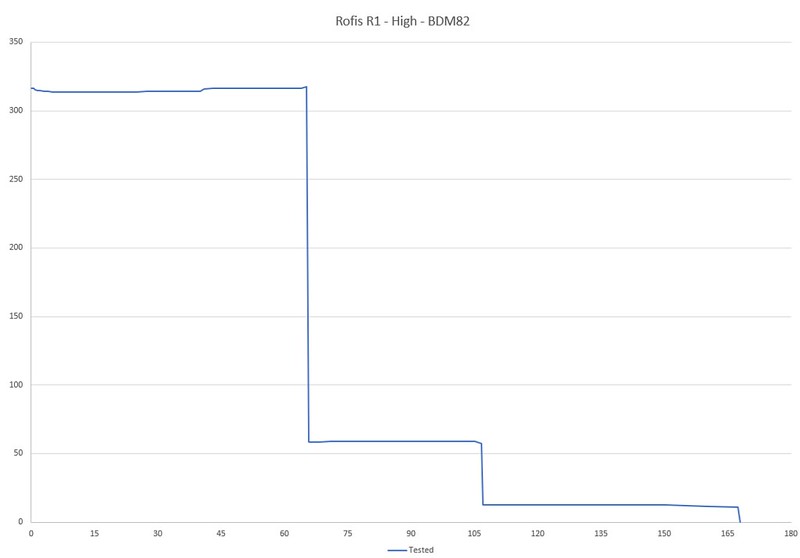
Medium is rated at 60 lumens and 7.5 hours. Testing validated this almost exactly at 59 lumens and 7.3 hours. The curve was also flat, maintaining 59 lumens until 7 hours and 17 minutes when it stepped down to 12 lumens. I concluded the test shortly thereafter (not testing all the way to power off).
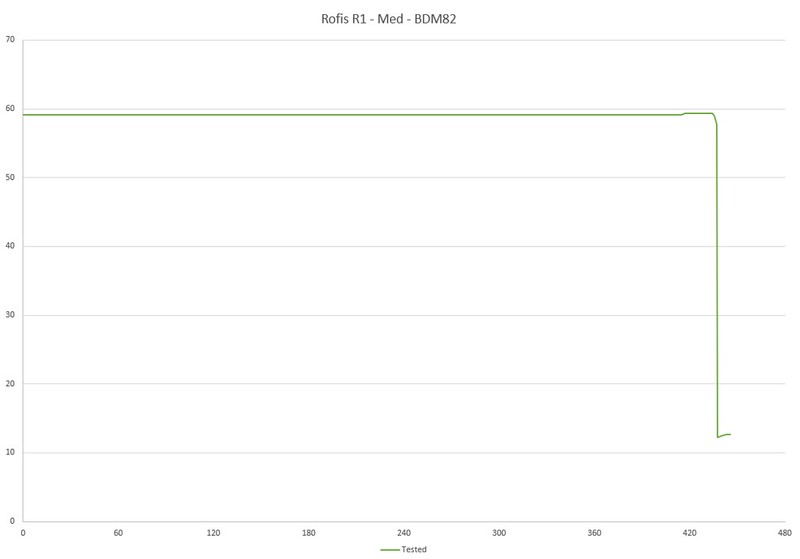
Low is rated at 10 lumens and 40 hours. I tested it at 13 lumens. Runtime not was tested.
Ultralow (moon light) mode is rated at 0.5 lumens for 20 days (480 hours). I found a slightly dimmer 0.3 lumens when tested. Runtime was not tested.
All outputs:
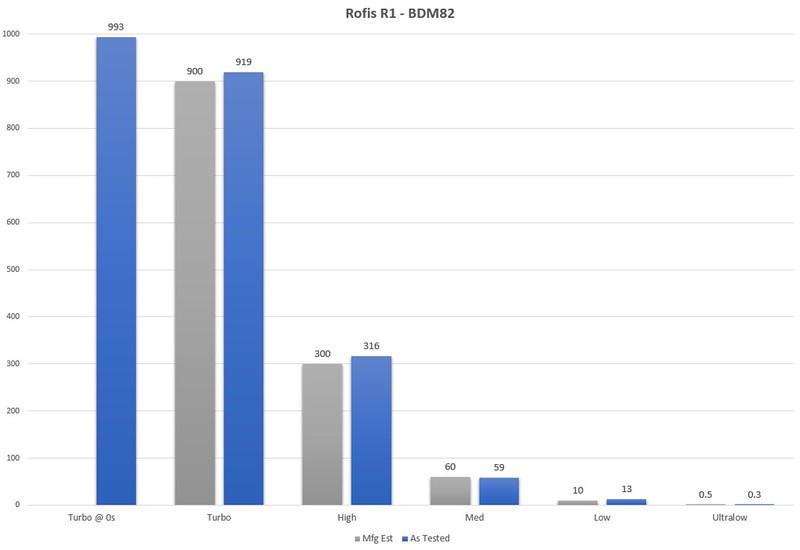
All runtimes tested:

Amperage Draw
As measured with fully charged cell:
Throw
I tested throw distance at 1.46 meters and the resulting candela was 5563 at 30 seconds - equivalent to 149 meters of throw.
Rofis rates the R1 at 5625 Cd and 150 meters of throw – almost exactly what I tested.
PWM
No PWM was detected visually or using a camera's CMOS sensor.
Parasitic Drain
The R1 uses an electronic switch so some parasitic drain is to be expected. That said, I tested it at an extremely low 34 μA – meaning the R1 would take over 2 years to drain the fully-charged 700mAh battery.
Low Voltage Battery Protection
The cell's low-voltage protection was tripped on all tests. After allowing the cell to rest and resetting the protection circuit, I found the voltage varied between 3.02 and 3.20 volts. The R1's internal charger was able to reset the tripped cell. If the R1 itself has any low-voltage protection (that doesn't rely on a protected cell to trip), it was not detected and is lower than 3.0V.
Internal Charging
The R1's magnetic charger is rated by Rofis at 0.5A. Using an inline USB meter, I registered 0.46A. The internal charger is capable of resetting cells with tripped protection circuits – which is good as the R1 allows the cell to run down until the circuit is tripped.
While charging, the switch is backlit in red.

Once charging is complete, the switch is backlit in green. Both red and green were bright and easy to identify. (Disregard the mAh displayed on the meter; the cell was not fully drained when charging started.)
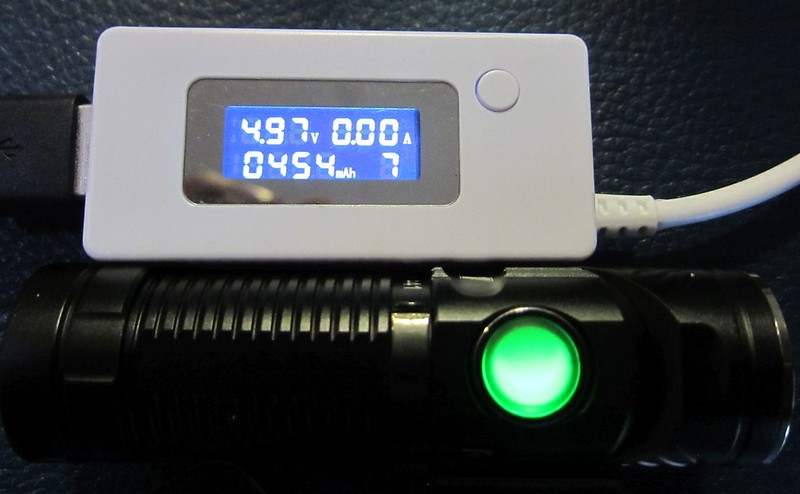
Impact Resistance
Rofis rates the R1's impact resistance at 1 meter. I do not intentionally test impact resistance, but sometimes it happens anyway. I was holding the R1 at chest height (about 1.25 meters) and it slipped from my hand. I attempted to catch it with a downward swoop, but instead just batted it straight down into the ceramic tile floor even harder. The R1 landed on its side and suffered no damage, despite the impact exceeding the 1 meter the R1 is rated for.
Outdoor Beamshots
Will be taken and posted at a later time. Unfortunately, I wasn't able to get any good beamshots due to snow on the ground reflecting ambient light.

Interface
The interface is easy to use but fully-featured, with mode memory, lockout, and direct access to both Moonlight and Turbo.
From off:
From on:
All normal modes (Low/Medium/High) are memorized. Moonlight, Turbo, Strobe and SOS are not memorized.
Problems
No problems were experienced with the Rofis R1 while testing.
Commentary
I really appreciate it when my test results match the manufacturer's specifications closely. Not only does it add authenticity to the manufacturer's claims, but it usually means consistent sourcing and quality controls from light to light.
The R1 as tested matched specifications as closely as any light I've tested. Even the runtime graph I produced closely matched that found on Rofis's website.
As for the R1's actual features, there's a lot I'm pleased with. The internal charger is convenient and the indicator LED under the switch makes it easy to check on remaining battery life. An extremely low parasitic drain also means the battery will retain charge in storage – and mechanical lockout is possible to reduce to totally stop the drain if needed for longer-term storage.
The R1 has a nice variety of outputs from <0.5 lumens to >900 lumens, all without the use of PWM. It's also versatile not only in brightness but actual use scenarios. A pocket clip, magnetic tail, and even headband for headlamp use are all included – as is a battery.
Initially I thought the adjustable head would only be a novelty, but I found it really handy in random situations. For example, I was using the barbeque grill and needed some light – I grabbed the R1, clipped it to my quarter-zip pullover, and adjusted the head to be angled down towards the grill.
Nothing is perfect, and the R1 is no exception. The tint in the spill is cool; this will not be to the liking to everybody. I personally expect cool tints in small lights pushing the limits for max output – but a neutral tint version that gives up a few lumens would be welcome.
My biggest wish for the R1 would be to see the location of the charging port and switch swapped. Accessing the switch when the light is in the headband is a little tight with where it is today; swapping the switch to the head of the light would put it on the end when the light is adjusted right-angle (like when worn on a headband).
The charging port itself is also both a feature and a drawback. On one hand, it's super easy to use and works well – and avoids relying on fragile rubber covers to maintain water resistance like models from other brands. On the other hand, it is proprietary and requires its own cable instead of using a common micro USB connector.
The Rofis R1 is a versatile high-output flashlight and headlamp that delivers all promised specifications – including output of 900+ lumens. The tint is cool but the variety of features packed into the R1 make it worth considering as an EDC light.
Lux Meter: Dr. Meter LX1330B
Integrating "sphere": Homebuilt tube-style device calibrated on other known lights and test results. Numbers should be considered relative to each other and my other review figures but accuracy is in no way certified or guaranteed.
Camera: Canon SD4000IS
Micrometer: Mitutoyo CD-6ASX
Multimeter: Craftsman 82170

Here are the key review details:

Skip to the commentary section at bottom to read my subjective notes on the R1.
Disclaimer: This light was provided free of charge by Rofis, shipping direct from Hong Kong. As December 24, 2017, the light can be purchased through Amazon (U.S.), Gearbest, or Banggood for $69.95. This review was completed over about 6 weeks of testing and real-world use.
Unboxing
The R1 arrived well-packaged; the retail box was nestled in a padded cardboard box inside the shipping envelope.

The front of the retail box advertises the LED, output, battery, and magnetic recharging.

With the false front open, many more features of the R1 are presented – as well as a window to see the R1 itself.

ANSI specs are presented on one of the box sides.

The other side has images of the light and headband. The rear has a runtime and output table as well as other information about the R1's features and Rofis as a company.

Rofis includes everything that's possibly needed with the R1: two spare o-rings, headband, lanyard (tucked inside headlamp mount), pocket click (pre-installed), battery (pre-installed), charging cable, warranty card, and instruction manual.

The manual itself is written in 7 languages: English, Chinese, French, German, Spanish, Italian, and Japanese. Content is quite complete though text is small.
The manual is also available online:
http://www.rofislight.com/wp-content/uploads/2017/09/ROFIS-R1-USER-MANUAL.pdf
Rofis backs the R1 with a 5-year warranty. Repair after 5 years is available for the cost of shipping and parts.
Design
The Rofis R1 is a small, easily pocketable RCR123 (16340) -based flashlight. It is about the same size as Rofis R10, its non-rechargeable stablemate. The R1 is slightly longer than a single 18650.
Rofis lists the length at 79.8 mm (69.6 mm when in right-angle mode), width at 22 mm, and weight at 67 g. My measurements confirmed these specs to the nearest mm/g noting that the battery tube is 20.2 mm.
For comparison, here is the R1 with various other lights (and the batteries they use).
L to R: Olight R50 Pro (26650), Manker E11 (AA), Astrolux S41S (18350), 18650 battery, Rofis R1 (16340), Olight S1R (16340), Manker E02 (AAA), Lumintop Tool (AAA), Nitecore EC23 (18650).

Of those lights, the Olight S1R is the closest direct competitor to the R1. The Olight is a bit more compact, but what's unique about the R1 is the rotating head that allows it to transform into a right-angle light or headlamp. The other lights lack this versatility.

The R1 can be used with the head at any angle. There is a slight notch felt and click heard as the R1 hits straight or right-angle – but the R1 functions no matter how the head is adjusted.

Here's the R1 along with other small EDC-size lights (and the batteries they use).
L to R: Rofis 16340 battery, Fenix E15 (16340), Olight S1R (16340), Rofis R1 (16340), Thorfire TG06 (AA), BLF348 (AAA), Utorch UT01 (AA), Lumintop Tool (AAA), Orcatorch EA01 (AAA).

The head of R1 has a flat stainless bezel. Being flat, light won't escape if the light is placed head-down on a flat surface while on, but it is comfortable in a pocket. I was not able to remove the bezel by hand.

The lens is AR-coated. The coating is minimally purple, a good thing. The reflector is smooth and void of any imperfections. The XM-L2 emitter is centered well, though the reflector is shallow and there is space horizontally between the reflector and LED.

The head of the R1 has the charging port and a triangularly-shaped indention on each side that give the head a unique look.

The charging port is a dual-ring disc that the charging cable attaches to magnetically. When the head is oriented in a right angle, the charging port is on the end of the light.

The side switch is a translucent black rubber circle inside a stainless ring. The switch doubles as a battery indicator; when the tail cap is tightened it will glow green for 2 seconds if the charge is >50%, glow red if the charge is 10-50%, or flash red if the charge is <10%. When in use, the switch will also flash if the battery charge is nearly depleted.
The switch is moderately easy to locate in hand and has good feedback and responsiveness.

To one side of the switch is the Rofis logo; to the other side is the R1 logo and serial number. Both the Rofis and R1 embossing are set into slightly recessed areas – which should deter wear and tear on the embossing.

The R1's battery tube is slightly narrower than the rest of the light. It has ridges most of the way around the tube – other than two flat sides. There is no writing on these flat areas. I found they added useful grip to keep the light from spinning in hand when removing the tail cap.

The tail cap has a lanyard hole to one side. It isn't overly large so some patience (or a small tool) is required to thread the lanyard. Being on the side of the tail cap, it doesn't hinder tail standing at all.

The tail itself is basically flat. It has a magnet inside and is strong enough to hold the R1 vertically or horizontally. (Dust is visible on the tail cap in this picture but know the anodization is clean.)

The battery tube has anodized square-cut threads – so a partial turn of the tail cap will mechanically lock the light out. Lubrication is lacking – as visible in the picture below. An o-ring helps prevent water ingress; Rofis rates the R1 as IPX-8 to 2 meters underwater.

The tail cap has a single gold-colored spring.

The head has a single gold-colored post surrounded by a shallower ring. This adds protection against cells inserted backwards – but does mean that button-top cells are required.

I tested with other 16340 batteries and found that Fenix 700mAh and Nitecore NL166 650mAh button-top cells were functional, though Turbo did trip the protection on the Nitecore cell. Thus, I'd recommend using the provided Rofis battery or another highly capable cell like the Fenix.
Accessories
Pocket Clip
The pocket clip is designed for head-up carry only. The strength is just about right – it is strong enough to not come off easily but not so strong that it's difficult to install or remove. The square edge where the clip transitions to wrap the body of the light (just below the Rofis embossing here) can catch when slipping onto a pocket.

Headband
Right-angle flashlights make great headlamps – and Rofis included a headband and mount for this purpose. The R1 slips into the rubber mount from either direction. The band holds the R1 securely at whatever angle is desired. The pocket clip can be left in place, though in that case the clip goes outside of the rings while the light slips inside them. This can make installing and rotating the R1 challenging, so I found it best to remove the clip before using as a headlamp.

One drawback to the switch's location is that when on the headband, the switch is on the back side of the light. It is accessible but large fingers or gloved hands will find it tricky. If the charging port and switch were swapped, it would have put the switch on the end – making it easier to use.

Performance
Beam
The XM-L2 is a single die emitter so there's no crosshair to deal with like with quad-die emitters. The R1's smooth but shallow reflector produces a defined but wide hotspot. Spill is plenty bright to be useful.

Tint & Temperature
The color and CCT are not specified by Rofis but I found the XM-L2 to have a slightly yellow hotspot and very cool, blue spill. CCT also varied highly, registering between around 4800 in hotspot and 7900K out in the spill. Most of the hotspot was around 5000K with most of the spill around 6500K (tested on Medium).
To demonstrate the overall color balance, here is the R1 surrounded by lights with emitters of various tints and temperatures on lower output modes. Camera W/B set to daylight.
L to R: Fenix E15 (XP-G2 R5), Olight S1R (XM-L2), Nitecore EC23 (XHP35 HD E2), Rofis R1, Convoy S2+ (XM-L2 T6 4C), Convoy S2+ (XM-L2 T6 4C), BLF348 (219B SW50).

Alongside other cool temperature lights, the R1 blends in a bit more. Camera W/B still set to daylight; brighter modes due to lack of lower modes on some lights in shot.
L to R: Nitecore EC23 (XHP35 HD E2), Emisar D1vn (modded w/SST-40), Rofis R1, Convoy S2+ (XM-L2 U2 1B), Orcatorch EA01 (XP-G2 R5), Fenix E15 (XP-G2 R5)

Output
Rofis rates the R1 at 900 lumens on Turbo with the included 16340/RCR123 700mAh cell. The box and manual make it clear that the light then steps down to 300 lumens at 30 seconds, and that it does.
I tested 993 lumens at turn-on and 919 lumens at 30 seconds with ambient temperature of 72F (22C).
Output dropped sharply right at 30 seconds and stabilized at 314 lumens.

This output was maintained with flat regulation until just past 62 minutes – when output was reduced to 62 lumens. This is within 3 minutes of Rofis's provided runtime of 65 minutes – validating the specification. Eventually the R1 stepped down to 13 lumens at 1:46 and powered off at 2:57. Temperature never exceeded 102F (39C).

High is rated by Rofis at 300 lumens for 70 minutes. I measured a very close 316 lumens at 30 seconds. Output was flat, fluctuating only a couple lumens until after 65 minutes – when it stepped down to 59 lumens. It stepped down again at 1:47 to 13 lumens before turning off at 2:48. Rofis appears to have rated the runtime based on the first stepdown – but <10% wasn't reached until the second stepdown at 1:47.

Medium is rated at 60 lumens and 7.5 hours. Testing validated this almost exactly at 59 lumens and 7.3 hours. The curve was also flat, maintaining 59 lumens until 7 hours and 17 minutes when it stepped down to 12 lumens. I concluded the test shortly thereafter (not testing all the way to power off).

Low is rated at 10 lumens and 40 hours. I tested it at 13 lumens. Runtime not was tested.
Ultralow (moon light) mode is rated at 0.5 lumens for 20 days (480 hours). I found a slightly dimmer 0.3 lumens when tested. Runtime was not tested.
All outputs:

All runtimes tested:

Amperage Draw
As measured with fully charged cell:
- Turbo: 3.3A
- High: 0.55A
- Med: 101mA
- Low: 25mA
- Ultralow: 2.0mA
Throw
I tested throw distance at 1.46 meters and the resulting candela was 5563 at 30 seconds - equivalent to 149 meters of throw.
Rofis rates the R1 at 5625 Cd and 150 meters of throw – almost exactly what I tested.
PWM
No PWM was detected visually or using a camera's CMOS sensor.
Parasitic Drain
The R1 uses an electronic switch so some parasitic drain is to be expected. That said, I tested it at an extremely low 34 μA – meaning the R1 would take over 2 years to drain the fully-charged 700mAh battery.
Low Voltage Battery Protection
The cell's low-voltage protection was tripped on all tests. After allowing the cell to rest and resetting the protection circuit, I found the voltage varied between 3.02 and 3.20 volts. The R1's internal charger was able to reset the tripped cell. If the R1 itself has any low-voltage protection (that doesn't rely on a protected cell to trip), it was not detected and is lower than 3.0V.
Internal Charging
The R1's magnetic charger is rated by Rofis at 0.5A. Using an inline USB meter, I registered 0.46A. The internal charger is capable of resetting cells with tripped protection circuits – which is good as the R1 allows the cell to run down until the circuit is tripped.
While charging, the switch is backlit in red.

Once charging is complete, the switch is backlit in green. Both red and green were bright and easy to identify. (Disregard the mAh displayed on the meter; the cell was not fully drained when charging started.)

Impact Resistance
Rofis rates the R1's impact resistance at 1 meter. I do not intentionally test impact resistance, but sometimes it happens anyway. I was holding the R1 at chest height (about 1.25 meters) and it slipped from my hand. I attempted to catch it with a downward swoop, but instead just batted it straight down into the ceramic tile floor even harder. The R1 landed on its side and suffered no damage, despite the impact exceeding the 1 meter the R1 is rated for.
Outdoor Beamshots
Will be taken and posted at a later time. Unfortunately, I wasn't able to get any good beamshots due to snow on the ground reflecting ambient light.

Interface
The interface is easy to use but fully-featured, with mode memory, lockout, and direct access to both Moonlight and Turbo.
From off:
- Short press the switch to access the last mode used (mode memory).
- Double press to enter Turbo mode.
- Press and hold for 2 seconds to access Ultralow (Moonlight) mode.
- Press and hold for 3 seconds to enter lockout mode.
- Press and hold again for 3 seconds to unlock.
From on:
- Long press to cycle to a higher mode (L->M->H->L…).
- Double press to activate Turbo.
- Triple press to enter Strobe mode.
- Long press to enter SOS mode.
- Short press the side switch to power off.
All normal modes (Low/Medium/High) are memorized. Moonlight, Turbo, Strobe and SOS are not memorized.
Problems
No problems were experienced with the Rofis R1 while testing.
Commentary
I really appreciate it when my test results match the manufacturer's specifications closely. Not only does it add authenticity to the manufacturer's claims, but it usually means consistent sourcing and quality controls from light to light.
The R1 as tested matched specifications as closely as any light I've tested. Even the runtime graph I produced closely matched that found on Rofis's website.
As for the R1's actual features, there's a lot I'm pleased with. The internal charger is convenient and the indicator LED under the switch makes it easy to check on remaining battery life. An extremely low parasitic drain also means the battery will retain charge in storage – and mechanical lockout is possible to reduce to totally stop the drain if needed for longer-term storage.
The R1 has a nice variety of outputs from <0.5 lumens to >900 lumens, all without the use of PWM. It's also versatile not only in brightness but actual use scenarios. A pocket clip, magnetic tail, and even headband for headlamp use are all included – as is a battery.
Initially I thought the adjustable head would only be a novelty, but I found it really handy in random situations. For example, I was using the barbeque grill and needed some light – I grabbed the R1, clipped it to my quarter-zip pullover, and adjusted the head to be angled down towards the grill.
Nothing is perfect, and the R1 is no exception. The tint in the spill is cool; this will not be to the liking to everybody. I personally expect cool tints in small lights pushing the limits for max output – but a neutral tint version that gives up a few lumens would be welcome.
My biggest wish for the R1 would be to see the location of the charging port and switch swapped. Accessing the switch when the light is in the headband is a little tight with where it is today; swapping the switch to the head of the light would put it on the end when the light is adjusted right-angle (like when worn on a headband).
The charging port itself is also both a feature and a drawback. On one hand, it's super easy to use and works well – and avoids relying on fragile rubber covers to maintain water resistance like models from other brands. On the other hand, it is proprietary and requires its own cable instead of using a common micro USB connector.
The Rofis R1 is a versatile high-output flashlight and headlamp that delivers all promised specifications – including output of 900+ lumens. The tint is cool but the variety of features packed into the R1 make it worth considering as an EDC light.
Lux Meter: Dr. Meter LX1330B
Integrating "sphere": Homebuilt tube-style device calibrated on other known lights and test results. Numbers should be considered relative to each other and my other review figures but accuracy is in no way certified or guaranteed.
Camera: Canon SD4000IS
Micrometer: Mitutoyo CD-6ASX
Multimeter: Craftsman 82170
Last edited:


